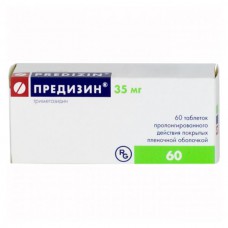Expiration date: 01/2026
Structure and Composition:
Sustained-release tablets, film-coated
Active substance (per 1 tablet):
Trimetazidine dihydrochloride 35 mg
Other ingredients: MCC - 88.22 mg Valium - 36.04 mg pregelatinized starch - 88.22 mg colloidal silicon dioxide 1.26 mg magnesium stearate - 1.26 mg
shell film: Opadry II 85G24057 - 7,5 mg (polyvinyl alcohol - 3.3 mg of talc - 1.5 mg titanium dioxide - 1.46025 mg macrogol 3350 - 0.92625 mg, soy lecithin - 0.2625 mg , iron oxide red dye - 0.02775 mg, iron oxide yellow dye - 0.0195 mg, dye black iron oxide - 0.00375 mg)
in blisters made of PVC / aluminum foil of 10 pieces. a stack of cardboard 6 blisters.
Description pharmaceutical form:
Biconvex round shaped tablet, film-coated pink.
Pharmacokinetics:
After oral trimetazidine rapidly and almost completely absorbed in the digestive tract, bioavailability - 90%.
Plasma Tmax of about 5 hours. After 24 hours the concentration in the blood plasma remains at levels above 75% concentration determined after 11 hours. An equilibrium state is reached after 60 hours. Food intake does not affect the pharmacokinetic properties of trimetazidine.
The apparent Vd is 4.8 L / kg, which explains a good diffusion in the tissues (contact with blood plasma proteins - low, about 16%) easily penetrates through the blood-tissue barriers.
Trimetazidine is excreted mainly by the kidneys (60% - unchanged). T1 / 2 in healthy volunteers is approximately 7 hours, in patients older than 65 years -. About 12 hours Renal clearance of trimetazidine is directly correlated with Cl creatinine, hepatic clearance is reduced with age. Increasing the T1 / 2 of trimetazidine in patients of advanced age has no clinical significance.
Description of the pharmacological actions:
Trimetazidine has anti-hypoxic action. Directly affecting cardiomyocytes and neurons in the brain, improves their metabolism and function. Cytoprotective effect is due to an increase in energy potential, activation of oxidative decarboxylation and rationalization of consumption of oxygen (aerobic glycolysis and strengthen the blockade of fatty acid oxidation).
It supports myocardial contractility, prevents a decrease in intracellular ATP and phosphocreatine. In acidosis conditions normalize the functioning of membrane ion channels, prevents the accumulation of sodium and calcium ions in cardiomyocytes normalizes intracellular concentration of potassium ions.
Reduces intracellular acidosis and elevated phosphate levels caused by myocardial ischemia and reperfusion. It prevents the damaging action of free radicals, preserves the integrity of cellular membranes, prevents activation of neutrophils in the ischemic area, increases the electric potential decreases the yield of the cells and creatine severity of ischemic myocardial injury.
When angina reduces the frequency of attacks and the need for the use of nitroglycerin, after 2 weeks of treatment, increases exercise tolerance, improved contractile function of the left ventricle in patients with coronary dysfunction, reduced blood pressure drops.
Reduces dizziness and tinnitus. In vascular pathology eyes improves the functional activity of the retina eyes.
Testimony:
Coronary heart disease: prevention of angina attacks (in the complex therapy)
cochle-vestibular disorders ischemic nature (dizziness, tinnitus, hearing loss).
Contraindications:
- Hypersensitivity to any component of the drug
- renal failure (Cl creatinine <15 ml / min)
- marked liver function abnormalities
- age of 18 years (effectiveness and safety have been established)
- pregnancy, lactation.
Application of pregnancy and breastfeeding:
Data on the safety of the drug in pregnancy, and therefore should be avoided by use of the drug during pregnancy Predizin.
Data on excretion into breast milk trimetazidine absent. If necessary, use during lactation should stop breastfeeding.
Side effect:
The frequency of side effects reported while taking trimetazidine, is given in accordance with the WHO classification: rare (& ge1 / 10,000 very often (& ge1 / 10) are often (& ge1 / 100, <1/10), uncommon (& ge1 / 1000, <1/100) <1/1000), very rare (</ 10,000), including isolated reports.
From the digestive system: often - abdominal pain, diarrhea, dyspepsia, nausea, vomiting.
General disorders: often - fatigue.
CNS: often - dizziness, headache, rarely - extrapyramidal disorders (tremor, rigidity, akinesia), reversible after the abolition of the drug.
For the skin and subcutaneous fat: often - skin rash, itching, hives.
From the CCC: rarely - orthostatic hypotension, a rush of blood to the skin.
Drug Interactions:
No information.
Dosage and administration:
Inside.
According to Table 1. 35 mg 2 times a day, morning and evening meals. Duration of the course - on doctor's advice.
Overdose:
There is only limited information on overdose of trimetazidine in the event of an overdose should be symptomatic therapy.
Precautionary measures:
Do not use the drug Predizin for the relief of angina attacks! The drug is not indicated for the initial course of therapy of unstable angina or myocardial infarction. In the case of angina attack should review and adapt therapy.
Effects on ability to drive or to perform work requiring higher rate of physical and mental reactions. Use of the drug Predizin does not affect the ability to drive vehicles and perform activities that require a high rate of psychomotor reactions.


